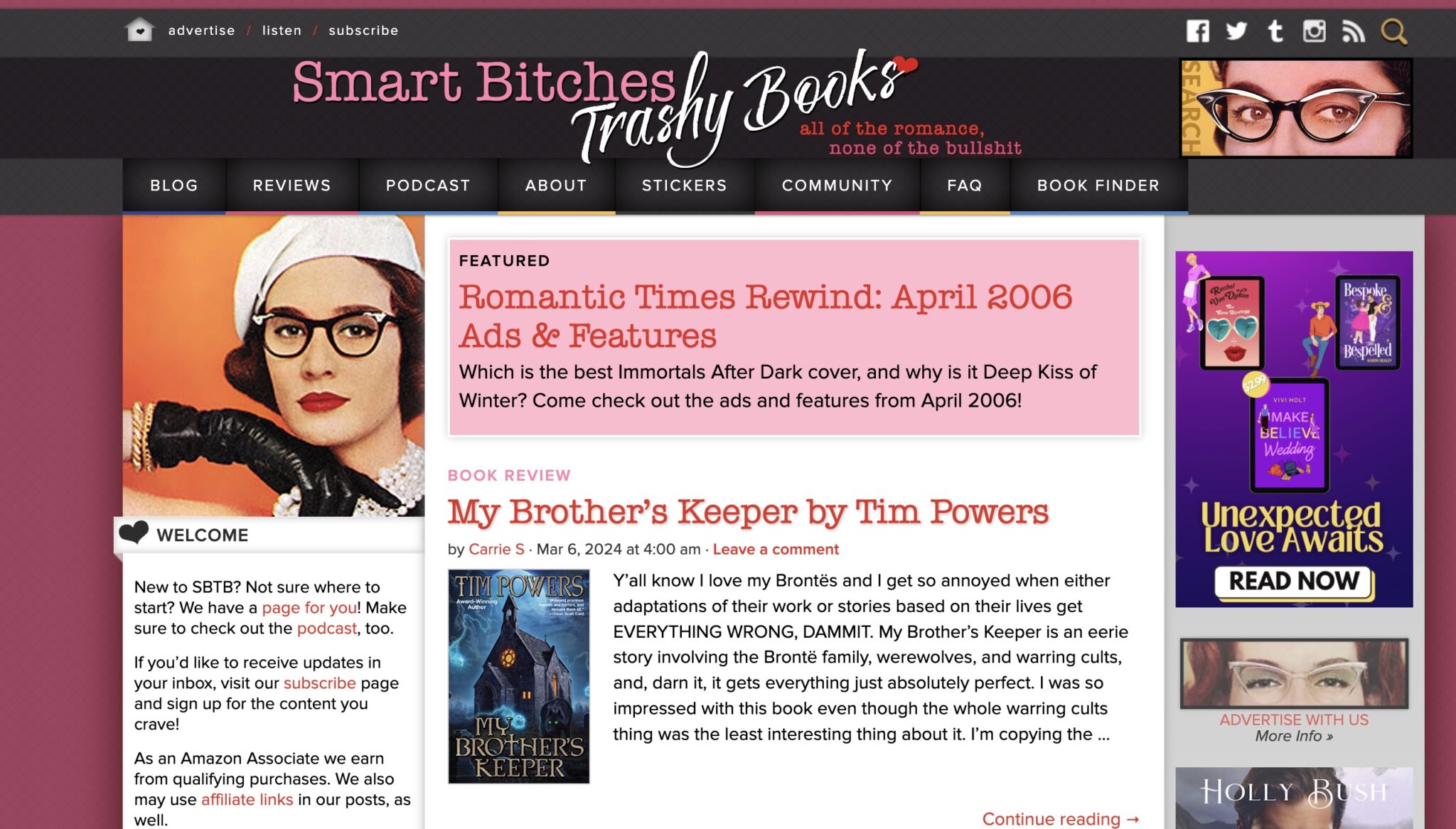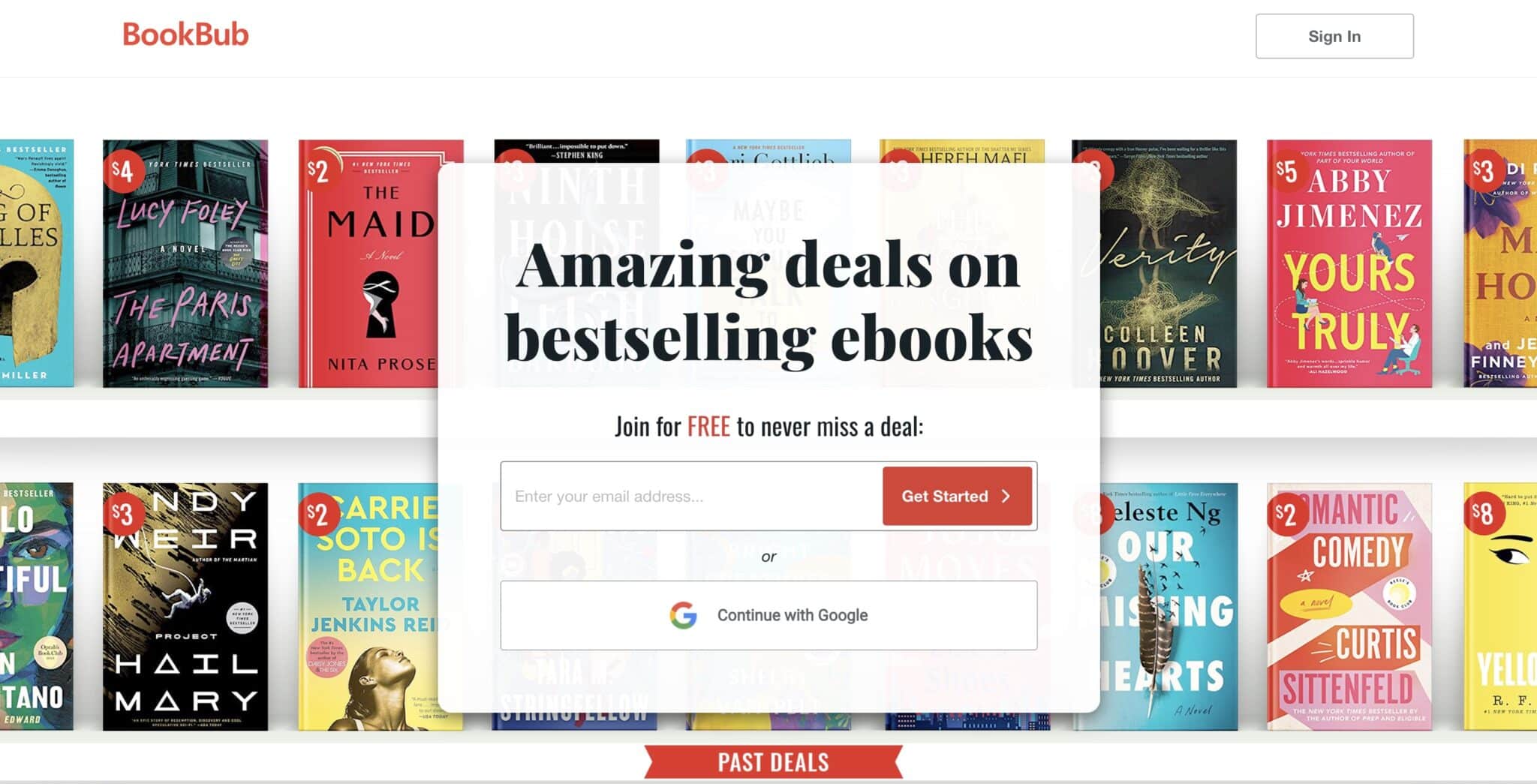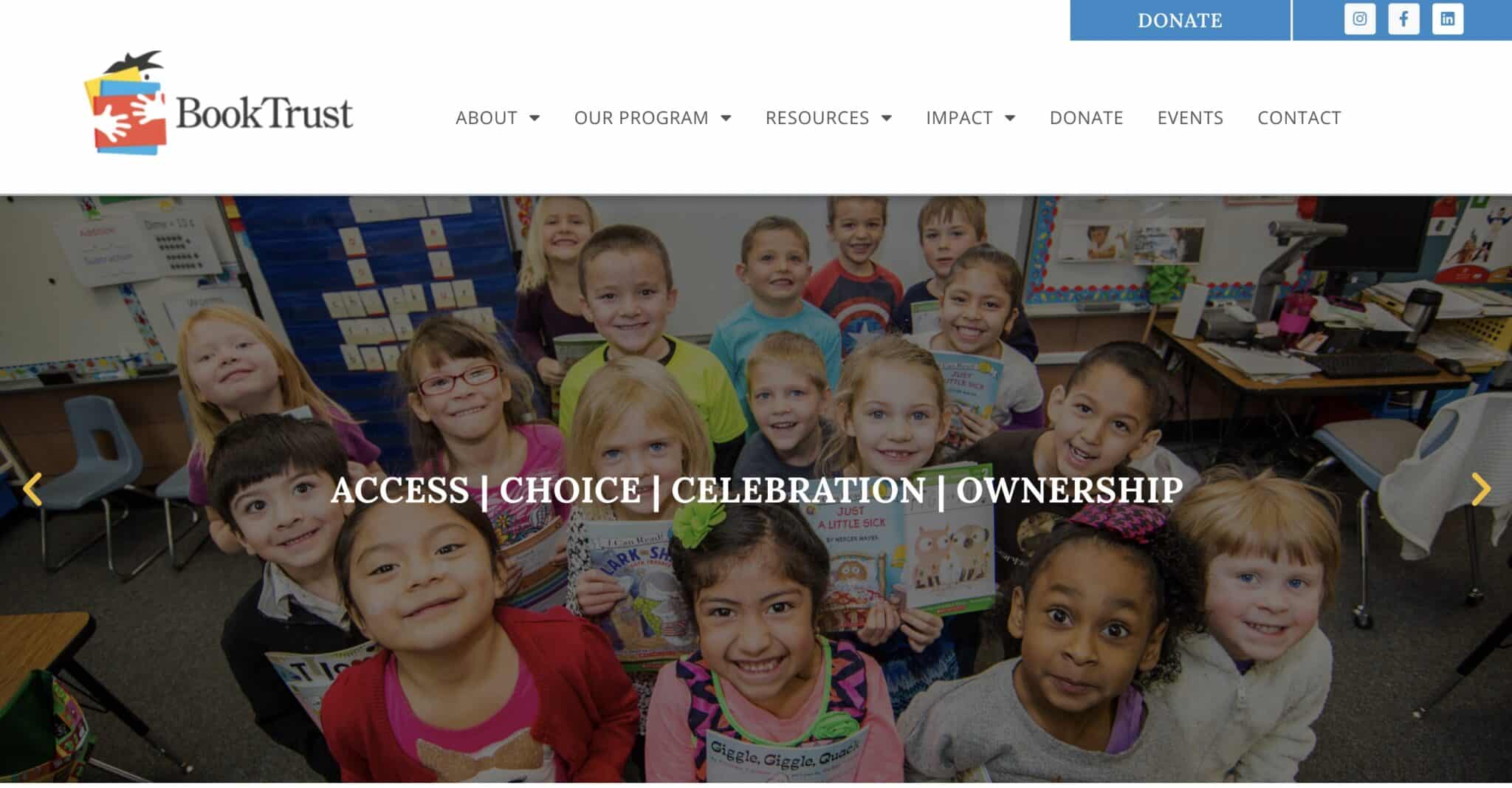Have you ever finished a really cool book and wanted to talk about it with someone? Or found a fantastic book you just couldn’t wait to tell everyone about?
If you love reading, making a blog is a great way to share your passion. You can write book reviews, recommend novels, and connect with other book lovers online.
We understand you’re busy, so we’ve made starting a book blog simple. We’ll show you how to make a website, pick a template and name, and even what kinds of blog posts to write. Just follow these steps, and you’ll be ready to start sharing your love of books with the world.
Table of Contents
What’s a Book Blog?
A book blog is similar to an online journal that gets updated regularly. It’s a website where someone talks about books in a friendly way. Anyone can run a book blog – from professional reviewers to avid readers.
Some book blogs cover all kinds of books, while others focus on specific types. For example, one might talk about all sorts of books, while another might only review fiction or a particular genre.
On a book blog, you might write various types of posts, including book reviews, recommendations for reading apps, author backgrounds, new releases, etc.
Why You Should Start a Book Blog?
If you really love books and are thinking about starting a book blog, here are some reasons why you should go for it:
-
Discover New Reads: If you’re a book lover, starting a book blog lets you share your favorite reads with others, helping them find books they’ll enjoy.
-
Read More: Having a book blog gives you a reason to read even more than you already do. It’s like turning your hobby into a productive passion.
-
Build a Community: As your blog grows, you’ll connect with fellow bookworms who share your interests. It’s a chance to chat about books, exchange recommendations, and make new friends.
-
Join a Community: There’s a thriving community of book bloggers out there. By starting your own blog, you’ll become part of this vibrant community, sharing ideas and experiences with like-minded readers.
-
Make Money: Besides the joy of reading and sharing, a book blog can also bring in some extra cash. You can earn money through ads, affiliate links to book-selling sites like Amazon, or even by selling your own digital products like e-books or reading guides.
How to Start a Book Blog in 11 Steps
1. Figure Out Who You’re Writing For
Your target audience is the specific group of people you’re aiming your book blog at. It could be based on age, location, gender, or interests.
Knowing your target audience helps you decide what your blog will focus on, how you’ll write your posts, and how your blog will look.
For instance, if your audience is younger readers:
- Pick fun and exciting book genres like fantasy or sci-fi.
- Write in a casual style, using everyday language and maybe some slang. Throw in funny pictures or GIFs to keep things lively.
- Make your blog visually appealing with bright colors and dynamic features. And make sure it works well on mobile phones.
But if your audience is older:
- Concentrate on more serious books, like non-fiction or self-help.
- Keep your writing conversational but a bit more formal. Limit the slang, but don’t be afraid to inject some humor.
- Sprinkle in some pictures to break up the text, but make sure they match your content.
- Opt for a clean, simple website design instead of something flashy.
Remember, these are just guidelines. Feel free to try new things and see what works for your audience. But always keep your target audience in mind when you’re making decisions about your blog.
2. Narrow Down Your Book Niche
There are so many books out there covering all kinds of topics. If you want to start a book review blog, you can’t cover everything. It’s like trying to eat a whole cake in one bite! So, you gotta narrow down your focus.
Why? Well, people like reading about content they’re into. If you love biographies, you’d rather read a blog all about biographies than one that talks about everything from romance to horror.
A narrower focus also means less competition and more dedicated readers. When you’re not lost in the crowd, it’s far easier to stand out.
But be aware, if your niche is super rare, you might struggle to find readers. Less competition also means fewer people looking for what you offer.
Here are some ideas to help you choose your blogging focus:
- Go beyond just fiction or non-fiction. Dive into specific genres like romance, horror, fantasy, sci-fi, or classics.
- Get even more specific. Build your blog around a particular book series or the works of certain authors.
- Focus on a specific theme. Maybe you want to review books that feature people of color or analyze them from a feminist perspective.
- Explore tropes and characters. Discuss how books use common stereotypes and whether it works for the story or not.
Pick something you’re passionate about. But also make sure it’s popular enough for your blog to succeed. Look for areas where other blogs are getting lots of readers and making money. That way, you’re not just talking to yourself!
3. Choose a Blogging Platform
A blogging platform helps you make and manage your blog or website.
There are two main types: content management systems (CMS) and website builders.
CMS lets you create and edit your blog using a simple interface. No coding needed! You’ll need a web host for your site, but don’t worry – reliable hosts can help you pick the right plan.
Popular CMS options include:
- WordPress.org: Easy to use and versatile. Great for all kinds of websites.
- Joomla: Gives you lots of control over users and languages.
- Drupal: Known for speed and security, good for specialized sites.
You can also use website builders. These tools let you design your blog with a drag-and-drop interface, no coding required.
Some popular website builders are:
- Hostinger Website Builder: Offers AI tools like AI Writer and Logo Maker.
- Wix: Has over 500 templates and a marketplace for add-ons.
- Squarespace: Known for its beautiful templates and third-party apps.
Some beginners go for free social blogging platforms like Medium or Blogger. They seem like a money-saver, but there are big downsides:
- You can’t make your blog look exactly how you want.
- Some content might not be allowed.
- It’s hard to make money from your blog.
Making your own website is smarter if you want total freedom and more money-making options.
Lots of successful bloggers make big bucks with their own sites. They couldn’t have done it on the more limited platforms.
The best choice for most bloggers is WordPress – but make sure it’s WordPress.org, not WordPress.com. Check out our guide on how to start a WordPress blog.
4. Choose Your Domain Name
A domain name is like the street address for your website or blog, such as www.hostinger.com.
For a book blog, the domain name usually matches or is similar to the blog’s name. So, when you’re thinking up names for your book blog, you’re also picking its web address.
Choosing the right domain name matters. If it’s too long or complicated, people might forget it or have trouble typing it into their browser. This could mean fewer visitors to your site.
Here are some tips for picking a good domain name:
- Go for a .com domain if possible. It’s the most recognizable and trusted extension, but there are other options to consider too.
- Make sure it matches your blog’s topic or niche. For instance, if you’re running a romance book blog, a name like ravishingreads.com could work well.
- Keep it broad enough to allow for future expansion. Don’t box yourself in with a name that’s too specific to one topic.
- Keep it short. Shorter domain names are easier to remember and type, so try to stick to no more than three words.
- Check for trademarks to avoid legal issues. You can do this through the USPTO website to ensure your chosen name is available.
If you’re struggling to come up with an available domain name, consider using AI domain generators like Brandsnap to help you brainstorm. Once you’ve decided on a domain name, here’s how to buy it:
- Find a trustworthy domain registrar.
- Use a domain checker to see if your chosen name is available.
- Pick your desired domain name or explore alternatives with a domain name generator.
- Buy the domain and fill in the registration details.
- Verify ownership through the email you used for registration.
5. Pick a Web Design Theme
Your blog’s theme is important because it shapes how visitors see your site and how easy it is for them to use. The right theme should be easy to read and navigate, matching your blog’s style.
Thankfully, there are many themes available, especially for WordPress users who can choose from free ones on WordPress’s directory or paid ones on other sites like ThemeForest.
Here’s how to pick the best theme for you:
- List what you need: Figure out what features you want, like how many columns or where to put the sidebar.
- Choose light and responsive themes: Avoid heavy themes that slow down your site. Pick ones that look good on any device.
- Consider your budget: Decide if you want a free or paid theme.
- Think about colors and fonts: Choose a theme with appealing colors and fonts that are easy to read.
- Test the theme: Try it out to make sure it looks good and works well.
If you’re running a book blog, you might want a theme that showcases book-related images and uses script or typeset fonts. Some themes even let you display a grid of the books you’ve reviewed.
You can go with a free WordPress theme or opt for a premium one for more features.
Starting with a free theme is fine, but make sure it offers a paid upgrade option. Free themes often have limitations that can hold you back as your blog grows.
Some great themes for new blogs are “freemium” themes like Astra, Kadence, and GeneratePress. They come with template libraries to help you get started quickly and offer free versions that you can upgrade later.
Once you’ve chosen a theme, here’s a simple guide to installing it on your blog:
- Step 1: Go to your WordPress dashboard.
- Step 2: Navigate to Appearance > Themes in the left sidebar.
- Step 3: Click on “Add New”.
And that’s it! With your theme installed, you’re ready to start customizing your new website.
6. Decide on Branding
Your WordPress theme sets up your site’s basics, but now it’s time to add your personal touch to match your brand and niche.
Start by choosing a color palette, which is the set of colors you’ll use throughout your site. These colors will affect your design, so choose wisely.
Try to pick colors that fit your book niche. For instance, a mystery book blog could use dark green, burgundy, and navy blue, with touches of silver or pale grey.
You don’t have to be a design expert to create a great color palette. Use Coolors to find colors that work well together and suit your niche.
Once your colors are set, it’s time to design your logo. A logo shows that you’re a serious book blogger.
If your blog becomes popular, you can even use print-on-demand to make money off your logo. For example, you can print it on merchandises like T-shirts or mugs for your fans to buy.
Now, here are some tips to keep in mind when designing your logo:
- Think about what your blog is all about and what makes it different.
- Look at other book blogs to get ideas.
- Choose a style for your logo, like classic, modern, or quirky.
- Decide what type of logo you want, like just letters, pictures, or a mix.
- Pick a font that fits your logo and is easy to read.
- Use colors that go well together.
Your logo should match your niche and brand. Many book bloggers use logos with book-related imagery. For example, a romance book blog might have hearts coming out of a book with a simple script font.
You don’t need design skills to make a quality logo. Try using a Canva logo template and customize it to fit your blog.
Visit Canva, search for “book logo,” and personalize your favorite template to match your colors and branding.
7. Set Up Essential Pages
When setting up your blog, it’s important to go beyond just creating a logo. You need certain pages to clarify who you are, provide contact information, and protect yourself legally.
Here are the key pages to include:
-
About Me: Here’s where you can introduce yourself to your audience. Share a bit about your reading background and interests, explain why you started the blog, and let your readers know what they can look forward to.
-
Contact Page: Make it easy for your readers to reach out to you. Include a contact form, your email address, and links to your social media profiles.
-
Privacy Policy: Inform readers about what personal information you collect and how you use it (like names, emails, etc.).
-
Disclaimer: State that your opinions in book reviews are personal and not representative of others. This becomes more important if you start making money from your blog.
-
Terms and Conditions: Set rules for your blog, including what’s allowed and what’s not.
-
Refund/Exchange Policies: If you sell things, outline your policies. Also, let writers and publishers know which books you accept for review.
Creating new pages on WordPress is simple. Just log in to your dashboard, go to the “Pages” menu, and click “Add New.” Then you can start building your pages right away!
Remember, you have the right to update these pages as needed.
It’s worth noting that legal requirements for book blogging can vary by country. For example, in the US, you must disclose any money you make from affiliate links. Consulting a lawyer for help with your legal pages is a good idea.
7. Write Content
You’ve done a lot of groundwork, and now it’s time to create content for your new blog about books.
To attract readers to your blog, it’s better to focus on keywords. This means writing about topics related to books that people are searching for on Google.
Avoid targeting the most popular keywords right away. They’re competitive, and established sites dominate them. Instead, aim for keywords related to your niche with moderate search volume and less competition.
You can use tools like Ahrefs to find these keywords. Just enter a basic keyword, and it’ll suggest related terms with search volume estimates.
Once you have 10 blog post ideas based on your keyword research, it’s time to write.
Here are some tips for writing engaging book blog posts:
-
Understand what readers want to know when they search for your topic. Look at Amazon reviews to get insights.
-
Write in a conversational tone. Readers want authentic opinions, not formal reviews.
-
Stick to the topic. Address the specific search intent without veering off track.
-
Share personal experiences. Show you’re knowledgeable about the topic by sharing your insights and comparisons.
- Include visuals. Images and graphics enhance the reading experience, even in book reviews.
-
Interlink your posts. Guide readers to related content on your blog to keep them engaged and improve SEO.
-
Inject emotion into your writing. Let your passion for books shine through.
-
Get ideas from book platforms like Amazon and Goodreads. Explore what’s trending to stay relevant.
-
Cover book news and events. Write about new releases and literary festivals to attract readers.
-
To be a trusted reviewer, develop a clear rating system based on factors like writing style, plot, and characters.
Before you promote your book blog, it’s a good idea to have 3 to 5 blog posts already up on your website. This gives readers more to explore and shows them your expertise.
To make sure you enjoy writing and never feel rushed to publish, plan out when you’ll post articles for the rest of the month using an editorial calendar.
8. Promote Your Book Blog
Once your blog is set up, it’s time to get the word out and promote it. Here are some easy ways to do that:
-
Share on Social Media: Platforms like Instagram, Pinterest, Facebook groups, YouTube, and TikTok have large communities of book lovers. Use hashtags like #bookstagram to reach a wider audience. Make it easy for readers to share your posts by adding sharing buttons at the end of each article.
-
Build an Email List: Offer a reading-focused giveaway or valuable tips in exchange for visitors signing up to your email list. Then, keep them updated with new posts, merchandise, or events through email newsletters. This works best once you have a loyal reader base.
-
Collaborate with Other Bloggers or Influencers: Partner with fellow book bloggers to promote each other’s content to your respective audiences. This works especially well if your niches complement each other, like horror and sci-fi. You can also use paid partnerships to work with influential figures in the book blogging community.
-
Join or Start Reading Groups: Engage with local reading groups to spread the word about your blog. These groups are often filled with avid readers who might be interested in your content. You can also participate in virtual book clubs and discussions, and mention your blog while engaging with others.
- Buy Advertisements: Consider investing in paid advertisements on platforms like Google Ads or Facebook Ads to reach a wider audience.
-
Interview Local Authors and Booksellers: Reach out to authors and bookstores in your area for interviews. This not only provides valuable content for your blog but also helps them gain exposure to your audience.
- Guest Blogging: Write for other established blogs in your niche to attract their readership to your own blog. In return, you may ask for inserting a backlink in your guest post. That you, you can drive traffic to your blog.
9. Monetize Your Blog
If you want to turn your passion project into a money-maker, you need to monetize your website properly.
There are several ways to make money online with your book blog:
-
Affiliate marketing: When you review books, recommend them to your readers and include special links to buy them. You’ll earn a commission when people click on these links and buy something from the partner’s site. Amazon is a good place to start because you can link to almost any book. You can check out our guide on starting affiliate marketing.
-
Display ads: You can put ads on your blog for free. These can be links, banners, or pop-ups. Depending on how the ads work, you might get paid for every visitor or for every click on the ad. You may sign up for beginner-friendly networks like Ezoic. As your traffic grows, you can switch to higher-paying networks like Mediavine or Raptive.
-
Sponsored posts: Companies pay you to write blog posts about their products or services. You can negotiate your payment with them. The amount you get paid might depend on factors like who writes the post and how many people visit your blog. This is a popular way for book review bloggers to make money.
- Freelance writing: You can offer your writing skills to different people or companies. You could write product reviews, guest posts for other blogs, or reviews of books.
-
Selling products: You can sell branded merchandise like mugs or hoodies with your logo on them. Or you could offer courses on writing in your genre and host them on Teachable. Some bloggers might even self-publish their own books using Amazon KDP.
Examples of Popular Book Blogs
We made a list of some awesome book blogs to inspire you and learn from their tactics.
1. Book Riot

Book Riot is the biggest independent book website in North America. They’re all about writing and reading, covering every genre you can think of. They offer lots of original content like articles, podcasts, newsletters, and more. It’s for everyone who loves books, no matter what kind you like!
2. Reedsy

Reedsy is a helpful place for writers. They provide resources for designing your book, marketing it, and improving your writing skills. Moreover, you can get advice on publishing from experts you can trust.
3. Smart Bitches Trashy Books

Smart Bitches Trashy Books is a fantastic community for romance readers. They’re all about having smart conversations about romance novels. It’s perfect for smart and sassy women. They have reviews, podcasts, and interesting blog posts to check out.
4. BookBub

BookBub is a website where you can find awesome book-related stuff. They share the latest news and info about books, authors, and adaptations. You’ll find content about all kinds of genres, from fiction to cookbooks.
5. BookTrust

BookTrust is a great platform for book lovers. They have lists of books for everyone and every genre. You can also find news, quizzes, quotes, and even join their community for fun interactions and giveaways. It’s all about enjoying quality reading content!
How to start a book blog FAQ
What Should Be Included in a Book Blog?
Your book blog should have a variety of book-related content, such as reviews, recommendations, and analyses. Use relevant, high-quality images and ensure your blog has essential pages like About Me, Contact, and legal pages (privacy policy, disclaimer, etc.). If you want to make money, consider adding affiliate links, ads, sponsored posts, or a merchandise section.
Is It Better to Start a Blog or Write a Book?
Starting a blog first is often recommended. Here’s why:
- Writer discipline: Blogging helps you stick to deadlines and boosts productivity.
- Writing skills: Regular blogging hones your skills faster through practice.
- Reader feedback: Blogging lets you learn about your audience’s interests.
- Faster process: Blog posts take less time to write and publish than books.
- Audience building: Consistent blogging builds a loyal readership and enhances your online presence.
Starting with a blog makes it easier to transition to writing a book later. Plus, your blog readers may become book buyers, and publishers may be more interested in your work due to your existing following.
Is it worth starting a book blog?
It depends on your goals. If you want quick cash, a book blog might not be the best choice. But if you love reading and are ready to put in the work, it’s a fantastic way to share your passion and maybe even earn a living.
Many book blogs still attract a large audience. Some get tens of thousands of visitors each month, while the most popular ones get even more. According to Detailed.com, the top book blogs receive hundreds of mentions on social media every month.
How often should you post on a book blog?
Most book bloggers recommend posting at least once a week, with some suggesting even more frequent updates. Regular posting helps to keep your audience engaged and enhances your blog’s visibility.
Remember, it’s better to focus on publishing one high-quality post per week than to produce several mediocre ones
Do book bloggers get free books?
Yes, they do! Publishers and authors often offer free books to bloggers for promotion. Bloggers can join review programs or contact publishers directly to request review copies.
Having a large and active audience can increase the likelihood of receiving free books, but newer or smaller bloggers might need to put in more effort to obtain them.
Final Words
A book blog is a website where you can regularly share thoughts about books in a casual style.
Starting a book blog is ideal if you love reading. It lets you share your passion, write reviews, express yourself, improve writing skills, connect with fellow book lovers, and potentially earn money.
To make your book blog successful, you’ll need to learn advanced strategies used by successful bloggers to grow their sites.
If you need more guidance, sign up for my online business coaching.

Jeff Smith, Founder of High Income Source, is an online business coach with a BBA in Marketing and Entrepreneurship from the University of Pennsylvania. His online business coaching program is so popular that more than 100 students have benefited and started successful online businesses under his guidance.
Jeff started dabbling in online business while he was in college, where he began with dropshipping. After college, Jeff worked at a marketing agency and freelanced as a writer. His breakthrough came when he realized the potential of blogging, leading to a $100,000 sale of a dog-focused website. His expertise includes SEO, affiliate marketing, Amazon FBA, blogging and dropshipping.